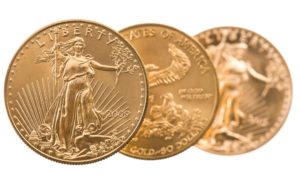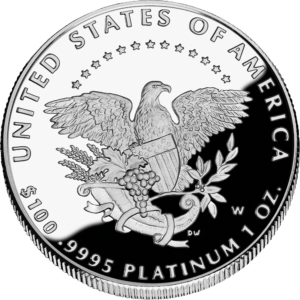Investing in Precious Metals
If you are reading this page, then you already know the value of investing in precious metals. Whether you invest in precious metals to preserve the purchasing power of your Dollars, want greater diversification in your portfolio, or have concerns about the direction that the United States is heading, investing in physical precious metals is one way to ensure that your wealth is preserved.
There are a number of ways to invest in precious metals. You can invest via
- A publicly traded entity such as an Exchange Traded Fund (ETF), Closed-End Fund (CEF), or Exchange Traded Note (ETN),
- Future contracts,
- Pooled Accounts, which provide unallocated ownership of precious metals,
- Physical Metals – allocated or direct ownership in specific coins, bars, or another form of holding the metals.
Many investors know that they can invest their IRA or 401k in precious metals via a publicly traded vehicle such as an ETF. What is less well-known is that investors can also use their retirement funds to invest inphysical precious metals without taking a distribution. They can do this through a self-directed IRA or self-directed 401k.
If you already have a self-directed IRA, then you may be aware that you can invest in physical precious metals (Gold, Silver, Platinum, and Palladium) with your retirement funds. The purpose of this page is to educate you about the self-directed IRA rules pertaining to physical precious metals. While this can be done easily enough, you must make sure you adhere to the rules written in the Internal Revenue Code (IRC). If this is done correctly, then you can sleep well at night knowing that your physical gold, silver, platinum, and palladium investments are helping to preserve the purchasing power of your retirement funds.
This document in intended for an audience who has a retirement account that is created under the Internal Revenue Code of the United States of America, and is interested in acquiring, holding and selling metals, such as gold, silver, platinum, palladium in their retirement account as an investment. The article does not go into the merits of whether an investment in metals is appropriate or not but provides the details of how one can invest in metals within the retirement account. If you are on this page, you most likely already know the merits of making this type of investment.
Types of Self-Directed Retirement Accounts
The Internal Revenue Code (IRC), which is also known as United States Code (USC), Title 26, specifically under sections 401 to 409A defines various types of retirement plans, most commonly known as: Employer-Sponsored Plans or Individual Retirement Plan. These include: 401(k), Individual 401(k), Solo 401(k), Traditional IRA, Rollover IRA, Inherited IRA, SIMPLE IRA, SEP IRA, ROTH IRA, 403(b), and many more similar and commonly named plans. All of the retirement accounts depicted here are either individual retirement accounts or individual-directed retirement accounts. There is no discussion on pension plans or equivalent. One should note that while attempting to make an investment through one of these retirement accounts, the rules of governance vary ever so slightly as they are governed by both the Internal Revenue Code as well as the Employee Retirement Income Security Act (ERISA – USC Title 29 Chapter 18).
Precious Metals – Self Directed Retirement Account Rules
- The general rule as provided under IRC Section 408(m)(2), states that “any metal or gem” or “any stamp or coin” is defined as a “collectible”.
- IRC Section 408(m)(1) states that “the acquisition by an individual retirement account or by an individually directed account of any collectible shall be treated as a distribution from such account in an amount equal to the cost to such account of such collectible.”
Based on the above two statements it is clear that a retirement account cannot invest in metals or coins. An investment in metals or coins would be deemed as a distribution.
In the typical fashion of laws, there are exceptions, wherein there is an exception provided for in IRC Section 408(m)(3), which states:
For the purposes of this subsection, the term “collectible” shall not include:
- any coin which is:
- a gold coin described in USC Title 31 Section 5112 (a) paragraphs (7),(8),(9) or (10)
- a silver coin described in USC Title 31 Section 5112 (e)
- a platinum coin described in USC Title 31 Section 5112 (k)
- a coin issued under the laws of any State
- any gold, silver, platinum, or palladium bullion of a fineness equal to or exceeding the minimum fineness that a contract market requires for metals which may be delivered in satisfaction of a regulated futures contract, if such bullion is in the physical possession of a trustee of the retirement account.
So with this exception, we are permitted to invest only in gold, silver, platinum coins and bullion and palladium bullion. We shall inspect each one of these in detail.
The Gold IRA
As indicated in the rules above, the permitted gold coins have to be of certain specifications:
- A fifty dollar gold coin that is 32.7 millimeters in diameter, weighs 33.931 grams, and contains one troy ounce of fine gold
- A twenty-five dollar gold coin that is 27.0 millimeters in diameter, weighs 16.966 grams, and contains one-half troy ounce of fine gold
- A ten dollar gold coin that is 22.0 millimeters in diameter, weighs 8.483 grams, and contains one-fourth troy ounce of fine gold
- A five dollar gold coin that is 16.5 millimeters in diameter, weighs 3.393 grams, and contains one-tenth troy ounce of fine gold
- have a design
- on the observe side, a design symbolic of Liberty; and
- on the reverse side, a design representing a family of an eagle, with the male carrying an olive branch and flying above a nest containing a female eagle and hatchlings;
- have inscriptions of the year of minting or issuance and the words “Liberty”, “In God We Trust”, “United States of America”, and “E Pluribus Unum”; and
- have reeded edges
All of these coins must be minted and issued by the Secretary of the Treasury to be permitted in a person’s retirement account.
Examples of Coins That Meet the Gold IRA Rules:
There are many coins that have similar names and physical appearance. The above requirements must be met. Here are some examples of coins that meet these requirements:
- Gold American Eagle
- Gold American Buffalo
The Silver IRA
Investing in Silver Coins
As indicated in the rules above, the permitted silver coins have to be of certain specifications:
- are 40.6 millimeters in diameter and weigh 31.103 grams;
- contains 0.999 fine silver;
- have a design:
- symbolic of Liberty on the observe side; and
- of an eagle on the reverse side;
- have inscriptions of the year of minting or issuance and the words “Liberty”, “In God We Trust”, “United States of America”, ‘1 Oz. Fine Silver”, “E Pluribus Unum”, and “One Dollar”; and
- have reeded edges.
The coins must be minted and issued by the Secretary of the Treasury to be permitted in a person’s retirement account.
Examples of Coins That Meet the Silver IRA Rules:
There are many coins that have similar names and physical appearance. The above requirements must be met. Here are some examples of coins that meet these requirements:
- Silver American Eagle
The Platinum IRA
As indicated in the rules above, the permitted platinum coins have to be of certain specifications:
- The Secretary may mint and issues proof platinum coins in accordance with such specifications, designs, varieties, quantities, denominations, and inscriptions as the Secretary, in the Secretary’s discretion, may prescribe from time to time.
Examples of Coins That Meet the Platinum IRA Rules:
There are many coins that have similar names and physical appearance. The above requirements must be met. Here are some examples of coins that meet these requirements:
- Platinum American Eagle
The Bullion IRA
As indicated in the rules, the permitted gold, silver, platinum, and palladium bullion must be of a fineness equal to or exceeding that a contract market requires for metals (for delivery in satisfaction of a regulated futures contract), which currently is:
- Gold Futures — 0.995 fineness (specified by the COMEX Rulebook Chapter 113)
- Silver Futures — 0.999 fineness (specified by the COMEX Rulebook Chapter 112)
- Platinum Futures —99.95% pure (specified by the COMEX Rulebook Chapter 105)
- Palladium Futures — 99.95% pure (specified by the COMEX Rulebook Chapter 106)
Currently, there is only The Commodity Exchange, Inc. (COMEX) that has been approved (by the United States Commodity Futures Trading Commission) as a Designated Contracts Markets for metals future contract markets, hence we are limited to the specifications as provided by COMEX.
The above information provides the fineness and quality of the precious metals, but there is no definition within the IRC as to what exactly constitutes “bullion”. Some information can be ascertained from prior case law, the generally acceptable term is defined as follows:
- Gold and silver intended to be coined. The term is usually applied to an amount of these metals ready for the mint, but as yet lying in bars, plates, lumps, or other masses; but it may also include ornaments or dishes of gold and silver, or foreign coins not current as money, when intended to be descriptive of its adaptability to be coined, and not of other purposes to which it may be put.
- Cases: Hope Min. Co. v. Kennon, 3 Mont. 44; Thalheim v. State, 38 Fla. 169, 20 South. 938; Counsel v. Min. Co., 5 Daly (N. Y.) 77.
Storage of Precious Metals Held in an IRA
 The second part of the requirement for the investment in metals is as follows:
The second part of the requirement for the investment in metals is as follows:
- For bullion, it is clearly specified in IRC Section 408(m)(3)(B), which states that the investment has to be in the physical possession of the trustee of the retirement account.
- For coins, it is not so straightforward in the definition. Under IRC Section 4975(c)(1)(C), which states that the term prohibited transaction means any direct or indirect furnishing of goods, services, or facilities between a plan and a disqualified person. Therefore this would preclude that use of the facilities of the account owner, or facilities under the direct control of the account owner, who is a disqualified person [IRC Section 4975(e)(2)], as the account owner is deemed as a fiduciary [IRC Section 4975(e)(2)(A)], as defined as any person who exercises any discretionary authority or control respecting management of such plan or exercises any authority or control respecting management or disposition of its assets [IRC Section 4975(e)(3)(A)]
Physical possession of the trustee of the retirement account does not automatically imply that the trustee is the one who gets to decide where it is deposited, how it is stored and when it can be moved as required to safeguard the investment, instead it is the account owner or the plan participant who owns the account, who decides and has to appropriately direct the trustee of the plan.
Some trustees may provide their own in-house safe-keeping facilities, as a value-added service to their clients, while others may work with metal depository services. Whichever method is employed, it should be noted that the trustee is the only one who can have access to the metals, and control the transaction of the purchase and sales, albeit under the direction of the account owner, or any authorized representative of the account owner.
You can contact us for more information.
Get our free report, 9 Common Mistakes Investors Make With Their Self-Directed IRA. In addition to this report you will receive updates and news related to precious metals and self-directed IRAs.
If you are looking for a self-Directed IRA Custodian or Administrator to provide custody for your precious metals, you should check out this List of Self-directed IRA Custodians and Administrators.
If you are looking for financial, legal or tax advice from a licensed professional, you should review this List of Self Directed IRA Advisors to find a professional in your area.
Disclosure and Disclaimer: The information provided in this article is based on material currently available at the time of writing this article. Conclusions in the articles are based on the opinion of the author. This article is purely for education and educational discussion purposes. While readers of the article may make investments based on the information provided in this article, the readers should be fully aware that there is no intent by the author or the company he represents to provide investment advice or recommendations solely based on this article, or any intent by the author or the company he represents to solicit or promote any investment products mentioned in this article. If any reader intends to make any investment, whether based on this article or otherwise, we recommend that they work with knowledgeable professionals who can guide them through specific details pertaining to their situations, after they have disclosed the pertinent facts to such professionals.




